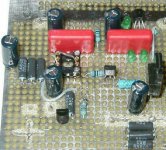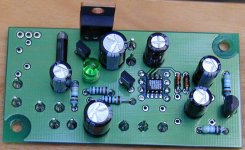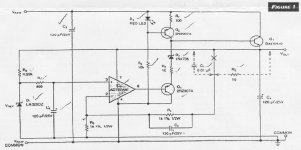Jung/Haller regulator
Jung type op amp regulator with different decoupling scheme, improved current source, and ZVP3310 mosfet driving Toshiba C3298 pass transistor. Waiting for AD8610 and OPA627 op amps for testing. Built on protoboard with top layer group plane. Weird parts layout for short signal path.
Jung type op amp regulator with different decoupling scheme, improved current source, and ZVP3310 mosfet driving Toshiba C3298 pass transistor. Waiting for AD8610 and OPA627 op amps for testing. Built on protoboard with top layer group plane. Weird parts layout for short signal path.
Attachments
Those new boards of yours look way better indeed.
I know it's homely, don't rub it in. This is a quicky test circuit board all was built for speed (and with speed) not looks. I hope to have it running tommorow.
I know it's homely, don't rub it in. This is a quicky test circuit board all was built for speed (and with speed) not looks. I hope to have it running tommorow.
Harry
Where do you get that ground plane proto board?
Could be useful for quick'n'dirty tests.
Andy.
P.S. Tested AD825 op-amps tonight, they are the dog's danglies in my preamp supply. They trade ultimate impedance and noise (realtive to AD797) for flatter impedance curve and better bandwidth, and sound much better to me. Musical whole just 'gels' better, more of a band, less a recording.
Where do you get that ground plane proto board?
Could be useful for quick'n'dirty tests.
Andy.
P.S. Tested AD825 op-amps tonight, they are the dog's danglies in my preamp supply. They trade ultimate impedance and noise (realtive to AD797) for flatter impedance curve and better bandwidth, and sound much better to me. Musical whole just 'gels' better, more of a band, less a recording.
Get Stuffed (More Jung/Didden stuff!)
Just for Harry, here's a pic of the new boards, on the test rig.
AD817 fitted for quick test purposes, AD825 provision is underneath.
Zetex transistors are substituted for the 2N2907's, in accordance with Jocko's new law 😉 (and giving better performance)
Enjoy...
Just for Harry, here's a pic of the new boards, on the test rig.
AD817 fitted for quick test purposes, AD825 provision is underneath.
Zetex transistors are substituted for the 2N2907's, in accordance with Jocko's new law 😉 (and giving better performance)
Enjoy...
Attachments
Just for Harry
WAY COOL!!!!!!! Very nice layout. Standard Jung design with 317 preregulator?
H.H.
WAY COOL!!!!!!! Very nice layout. Standard Jung design with 317 preregulator?
H.H.
Measurements
Jan,
None yet, I only built them this morning. Currently on burn-in and will measure noise tomorrow, hopefully.
Other results may take a little longer, I'm currently re-designing the impedance / line rejection jig.
Sonic evaluation of the first two I built, now nicely run-in are marvellous - I love the AD825, wish I could source some AD8610's, they model well. My sample request hasn't arrived 🙁
Regards,
A.
P.S. Did you ever get my email? - I never received anything back from you.
Jan,
None yet, I only built them this morning. Currently on burn-in and will measure noise tomorrow, hopefully.
Other results may take a little longer, I'm currently re-designing the impedance / line rejection jig.
Sonic evaluation of the first two I built, now nicely run-in are marvellous - I love the AD825, wish I could source some AD8610's, they model well. My sample request hasn't arrived 🙁
Regards,
A.
P.S. Did you ever get my email? - I never received anything back from you.
Stop it
You'll make me blush 😉
Essentially, but using different components. Caps are Rubycon ZA, there's additional decoupling to the op-amp (Nichicon PL) and the feedback low-pass network (when used) is differently configured from Walt's recommendation, because it didn't work for me.
Resistors are Beyschlag and the level-shift zener is a beefier 5W part too, but that was mainly an availability issue, it doesn't need to be this big.
Apart from that it's the same...
A.
You'll make me blush 😉
WAY COOL!!!!!!! Very nice layout. Standard Jung design with 317 preregulator?
Essentially, but using different components. Caps are Rubycon ZA, there's additional decoupling to the op-amp (Nichicon PL) and the feedback low-pass network (when used) is differently configured from Walt's recommendation, because it didn't work for me.
Resistors are Beyschlag and the level-shift zener is a beefier 5W part too, but that was mainly an availability issue, it doesn't need to be this big.
Apart from that it's the same...
A.
You'll make me blush
Don't be modest. I love the 45 degree orientation for the small transistors. How about photo of the bottom side. Great part choices, the Rubycon ZAs are new and simular to the Sanyo oscons I think. Very nice job. There are several oscon ( Organic SemiCONductor type caps on the market now.
http://www.low-esr.com/compare.html-ssi
http://www.vishay.com/products/capacitors/aluminum.html
http://www.sanyo.com/industrial/components/oscon_home.html
http://www.rubycon.co.jp/english/prodct/new2.htm
http://www.chemi-con.com/mapresults.php?series=fa
http://www.panasonic.com/industrial/components/pdf/eef_xr_1201.pdf
Don't be modest. I love the 45 degree orientation for the small transistors. How about photo of the bottom side. Great part choices, the Rubycon ZAs are new and simular to the Sanyo oscons I think. Very nice job. There are several oscon ( Organic SemiCONductor type caps on the market now.
http://www.low-esr.com/compare.html-ssi
http://www.vishay.com/products/capacitors/aluminum.html
http://www.sanyo.com/industrial/components/oscon_home.html
http://www.rubycon.co.jp/english/prodct/new2.htm
http://www.chemi-con.com/mapresults.php?series=fa
http://www.panasonic.com/industrial/components/pdf/eef_xr_1201.pdf
Feedback
Congratulations on an excellent looking assembly. It will certainly measure as good as it looks!
How did you configure low-pass feedback network and why do you say it now works better for you?
Carlos
Congratulations on an excellent looking assembly. It will certainly measure as good as it looks!
How did you configure low-pass feedback network and why do you say it now works better for you?
Carlos
os-con
Huge thanks for those links Harry - will investigate more.
The Sanyo OS-CON's are the only thing I've tried better than ZA's, but at considerable price, and working voltages are a bit low for some of my supplies.
I will investigate other options though, the ZA's are very good, but I'd like that OS-CON performance at a similar price, if I can get it.
"I love the 45 degree orientation for the small transistors."
More chance than anything else - the board was designed for 2N2907's, but I subbed the Zetex parts for price / performance reasons, and that's how they fit - does look kind of cool, I suppose 😉
Carlos,
The low-pass is only very slightly different - Walt returns it to the reg o/p, but this gives didn't have any effectr whatsoever on the oscillations I experienced - it gives a direct path from oscillating reg o/p to sense i/p.
Returning the 0.01 to 0V worked every single time, the effect is the same.
A.
Huge thanks for those links Harry - will investigate more.
The Sanyo OS-CON's are the only thing I've tried better than ZA's, but at considerable price, and working voltages are a bit low for some of my supplies.
I will investigate other options though, the ZA's are very good, but I'd like that OS-CON performance at a similar price, if I can get it.
"I love the 45 degree orientation for the small transistors."
More chance than anything else - the board was designed for 2N2907's, but I subbed the Zetex parts for price / performance reasons, and that's how they fit - does look kind of cool, I suppose 😉
Carlos,
The low-pass is only very slightly different - Walt returns it to the reg o/p, but this gives didn't have any effectr whatsoever on the oscillations I experienced - it gives a direct path from oscillating reg o/p to sense i/p.
Returning the 0.01 to 0V worked every single time, the effect is the same.
A.
Forgot one
Glad to be of use and one more:
http://www.nichicon.co.jp/english/seihin/solid/pict_f.htm
Also you may want to try the OPA637 which is compensated for a minimum gain of 5 but should be swamped by the output cap and might work. This is the same rational that Sulzer used for the NE5534 without compensation for his origional regulator design. An LF 357 would be a neat part to try even though it is an oldy. It is a fast and pretty quiet Jfet input op amp that not to different in specs than the AD825 or OPA627. Way ahead of its time I guess.
http://www.national.com/ds/LF/LF155.pdf
Glad to be of use and one more:
http://www.nichicon.co.jp/english/seihin/solid/pict_f.htm
Also you may want to try the OPA637 which is compensated for a minimum gain of 5 but should be swamped by the output cap and might work. This is the same rational that Sulzer used for the NE5534 without compensation for his origional regulator design. An LF 357 would be a neat part to try even though it is an oldy. It is a fast and pretty quiet Jfet input op amp that not to different in specs than the AD825 or OPA627. Way ahead of its time I guess.
http://www.national.com/ds/LF/LF155.pdf
Attachments
i read that u change the 2n5087 to a zetex transistor, what transistor did you choose for swapping this is for the 5 v supply
For negative supply how's the connection(swap transistors for the complimentary pair, change the position of the diodes and caps, any changes to the buried zener?)
For negative supply how's the connection(swap transistors for the complimentary pair, change the position of the diodes and caps, any changes to the buried zener?)
what transistor did you choose for swapping this is for the 5 v supply
Page 1 of this thread. Work with us here please, most all off this stuff has been posted.
H.H.
Page 1 of this thread. Work with us here please, most all off this stuff has been posted.
H.H.
- Status
- Not open for further replies.
- Home
- Amplifiers
- Solid State
- Reducing noise in voltage regulators




